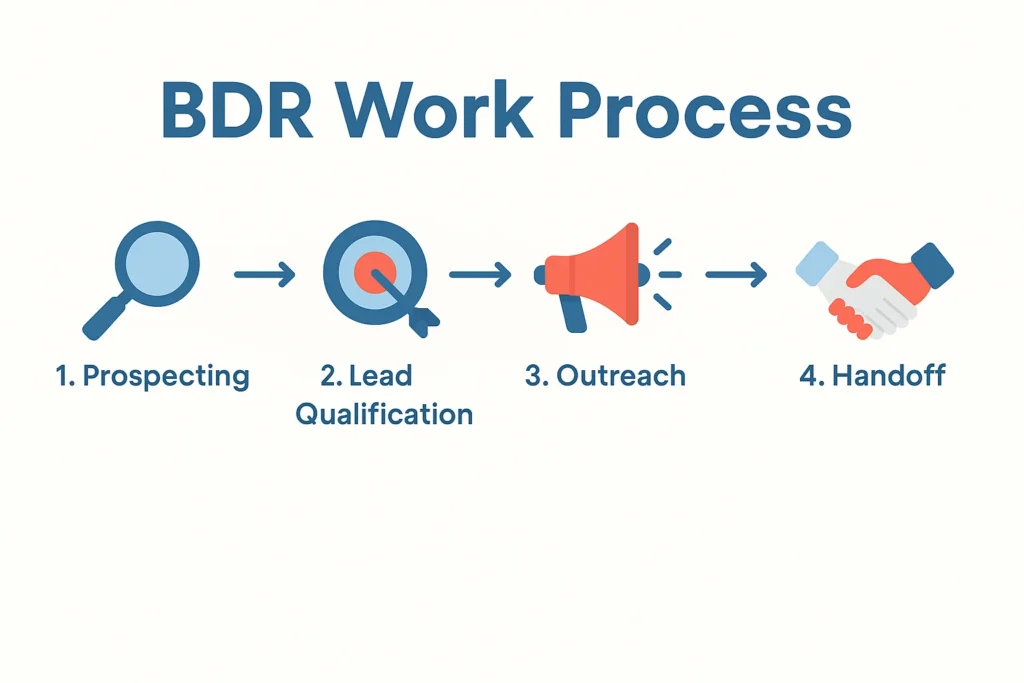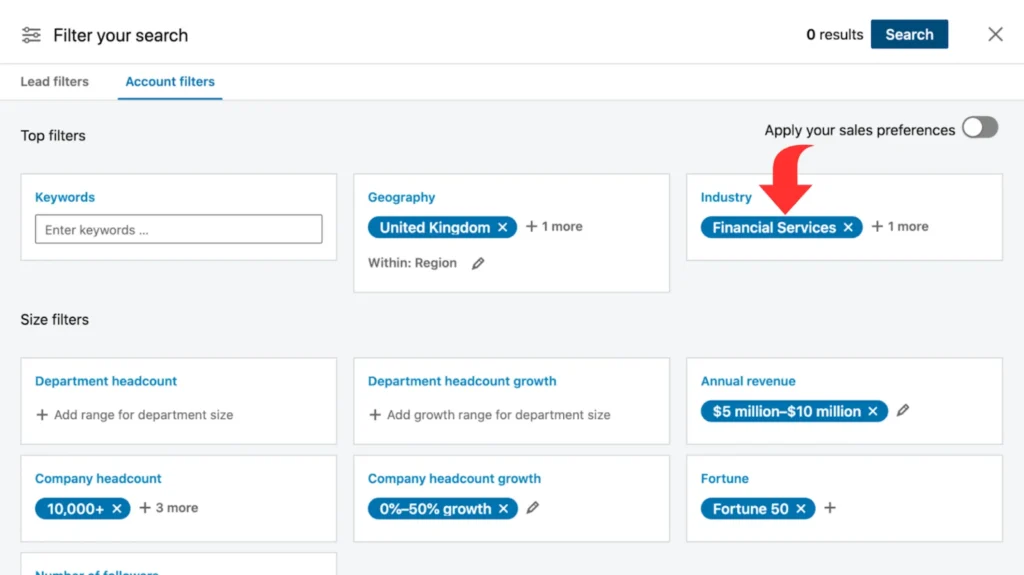In a sales ecosystem where efficiency and specialization define performance, the Business Development Representative (BDR) has become indispensable.
For growth-focused organizations, especially those with high-ticket or complex offerings, knowing what a BDR does (and why it matters) can sharpen the effectiveness of the entire sales funnel.
A BDR serves as the frontline of outbound efforts, qualifying prospects before they ever speak to a closer or account executive. This upfront filtering saves time and improves the quality of every downstream conversation.
For business owners, knowing how to leverage a BDR (whether as part of an in-house team or outsourced model) can directly impact revenue generation, lead quality, and customer retention.
As the lines between marketing and sales continue to blur, BDRs play a critical role in aligning these functions around qualified pipeline growth.
Table of Contents
What Does BDR Stand For in Sales?
BDR stands for Business Development Representative. In the context of modern B2B sales, this role focuses on outbound prospecting and top-of-funnel activities.
Unlike traditional salespeople who manage the entire buyer journey, BDRs specialize in identifying and qualifying new opportunities.
A BDR’s objective is not to close deals but to open doors. They conduct targeted outreach through channels like cold calls, email sequences, and social engagement. Their main KPI is typically the number of qualified leads or meetings booked for account executives.

It’s important not to confuse BDRs with SDRs (Sales Development Representatives). While these terms are often used interchangeably, some companies distinguish between them, assigning SDRs to inbound leads and BDRs to outbound efforts.
Regardless of the title, the emphasis is on pipeline creation. For business owners, strategically deploying BDRs can allow closers to focus on high-value interactions, accelerating deal velocity and improving conversion rates.
Key Responsibilities of a BDR
The role of a BDR is process-driven, data-informed, and outcome-oriented. While specific responsibilities may vary across organizations, the core functions remain consistent across B2B sales teams.
Below are the essential responsibilities a BDR is expected to fulfill:
- Outbound Prospecting: Initiating contact with potential customers through cold calls, emails, LinkedIn messaging, or other outreach methods. The goal is to create engagement where none existed before.
- Lead Qualification: Assessing prospects using criteria such as budget, authority, need, and timeline (BANT) to determine sales readiness before handing off to an account executive.
- Research and Account Mapping: Gathering intelligence about target companies, their pain points, key decision-makers, and buying triggers. It enables personalized outreach that resonates.
- CRM Management: Logging interactions, notes, and status updates in the CRM system to maintain data hygiene and ensure accurate pipeline tracking.
What Is Sales Pipeline In CRM? – BusinessGuide360.com
- Meeting Scheduling: Coordinating discovery calls or demos between qualified leads and sales closers. Timely follow-up and calendar alignment are crucial here.
- Performance Tracking: Monitoring outreach volume, response rates, booked meetings, and conversion metrics to iterate on what works.
- Alignment with Marketing: Providing feedback on lead quality, campaign effectiveness, and buyer objections to help refine targeting strategies and messaging.
Skills and Traits That Make a Successful BDR
Hiring or developing a high-performing BDR requires selecting someone with a particular skillset and mindset. The top BDRs consistently exhibit a blend of strategic thinking, communication mastery, and operational discipline.
Here are five core skills and traits that separate high-performing BDRs from the rest:
Prospecting Intelligence
Exceptional BDRs know how to identify high-value leads beyond surface-level data. They use tools like LinkedIn Sales Navigator, Crunchbase, or intent data platforms to identify relevant triggers, such as funding rounds, leadership changes, or technology stack shifts.

It allows outreach to be tailored and timely, which increases the likelihood of engagement.
Relentless Persistence
Rejection is built into the role. Successful BDRs are equipped with the mental stamina to handle low response rates without losing momentum. They view follow-ups not as an annoyance but as a professional discipline.
Persistence, when paired with tact, leads to significantly higher conversion rates over time.
Structured Communication
Top BDRs have a deep command of how to write and speak with clarity. They craft concise cold emails, speak confidently in voicemails, and tailor messaging to different personas.
Each touchpoint is part of a broader messaging sequence that aims to drive curiosity and value alignment.
Active Listening and Adaptability
While the role is outreach-heavy, the best BDRs also know when to pause and listen. They capture prospect pain points, objections, and hesitations with precision.
It allows them to pivot the conversation dynamically and deliver qualified leads that match the expectations of account executives.
Layers of Demand Generation | Demand Capture and Demand Creation
Process and CRM Discipline
A BDR must operate within structured frameworks: cadences, KPIs, and CRM protocols. The ability to maintain clean data, update lead statuses in real time, and follow workflow guidelines is non-negotiable.
Without this operational consistency, pipeline integrity may degrade, and forecasting accuracy will decline.
BDR vs SDR vs Account Executive: Understanding the Differences
In a specialized sales team, roles are segmented to increase efficiency and scale. Business Development Representatives (BDRs), Sales Development Representatives (SDRs), and Account Executives (AEs) all play distinct but interdependent roles.
- BDRs are usually responsible for outbound lead generation. They identify cold prospects, engage them, and qualify them through structured discovery.
- SDRs often handle inbound leads, responding to form submissions, marketing-qualified leads, or product signups.

Both roles aim to qualify prospects and schedule meetings, but their lead sources and outreach strategies differ. Metrics like meetings booked, email open rates, and call activity are their main KPIs.
- AEs, on the other hand, focus on closing deals. They take the qualified leads from BDRs or SDRs and guide them through solution presentations, negotiations, and final purchase decisions. Their KPIs are tied to revenue closed, deal size, and win rates.
The BDR-to-AE transition is a common career progression. After mastering qualification and outreach, BDRs gain the product and negotiation skills needed to move into full-cycle sales. This structured pathway supports internal mobility and leadership pipeline development.
Why BDRs Are Critical to Your Sales Pipeline
BDRs play a foundational role in generating pipeline predictability. While marketing attracts attention and AEs close deals, BDRs bridge that gap by qualifying intent and creating sales-ready opportunities.
A consistent flow of well-vetted leads reduces the likelihood of wasted AE time on poor-fit prospects. It tightens sales velocity and increases win rates, primarily when the lead handoff process is structured and precise.
Moreover, BDRs help organizations scale outreach without overwhelming closers. By managing top-of-funnel activities (research, cold outreach, follow-ups), they allow AEs to focus exclusively on negotiation, proposal management, and closing.
BDRs also act as market intelligence gatherers. Every conversation they have feeds valuable insights about objections, buyer intent signals, and evolving customer needs. This feedback loop improves messaging alignment across sales and marketing.
In enterprise environments, where deal cycles are long and stakeholders are many, BDRs become essential in multi-threading relationships early. They prime the account and build consensus before the AE steps in.
In short, without BDRs actively working at the top of the funnel, the pipeline dries up. Business owners looking for scalable, high-performance revenue operations must see BDRs not as junior staff but as the engine that keeps qualified opportunities flowing.
How to Structure and Manage a BDR Team Effectively
A well-structured BDR team requires more than just a group of reps making calls. It demands defined processes, consistent oversight, and alignment with revenue goals.
Here are key strategies for managing a high-performing BDR team:
- Segment by Role or Territory: Assign BDRs based on geography, vertical, or account type to increase relevance and reduce overlap.
Ultimate guide to strategize sales territory plan
- Establish Clear KPIs and Activity Metrics: Track outreach volume, meetings booked, SQL conversion rates, and response quality, focusing on both activity and outcome.
- Use an Integrated Tech Stack: Equip your team with tools like Salesloft, Outreach, or Apollo for cadence automation and CRM syncing to ensure scalable execution.
- Invest in Sales Enablement and Playbooks: Provide scripts, objection-handling frameworks, and persona-based messaging to reduce ramp time and improve consistency.
- Conduct Regular Coaching and Feedback Loops: To continually refine performance, hold weekly one-on-ones, call reviews, and data-based evaluations.
- Ensure Strong Alignment with AEs and Marketing: BDRs should receive ongoing input from AEs and marketers to maintain relevance, messaging cohesion, and feedback integration.
Common Mistakes When Hiring or Managing BDRs
Hiring or managing BDRs ineffectively can stall pipeline momentum and increase churn. These are some of the most frequent mistakes:
- Hiring Based on Enthusiasm Alone: Energy is not a substitute for research ability, structured thinking, or communication skills.
- Overloading Reps with Admin Work: Too much time spent on CRM updates or manual research drains outreach momentum.
- Neglecting Continuous Training: One-time onboarding isn’t enough. BDRs need structured coaching as markets evolve.
- Misaligning BDR and AE Goals: Without shared definitions of qualified leads, frustration builds between teams.
- Failing to Monitor Data Quality: Dirty CRM data or a lack of standardized tracking sabotages team performance analysis.
Conclusion and Strategic Takeaways
BDRs are precision instruments in a sophisticated sales system. When properly hired, trained, and empowered, they build predictable revenue pipelines, enhance cross-team collaboration, and shorten sales cycles.
For business owners, success lies in recognizing the strategic value of the BDR role and investing accordingly.
Clear KPIs, proper tooling, ongoing coaching, and alignment with broader GTM functions will ensure your BDR team delivers consistent, qualified opportunities to drive revenue growth.
As buying behavior grows more complex, those who invest early in refining their BDR structure will maintain a sustainable edge in competitive sales environments.


